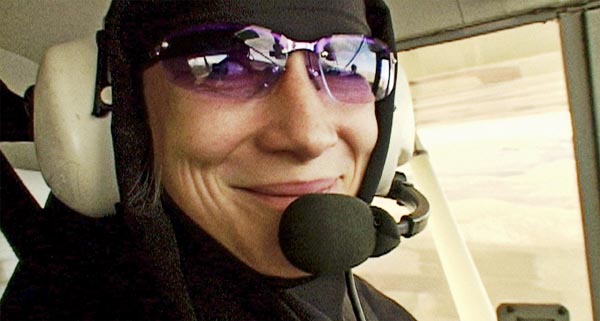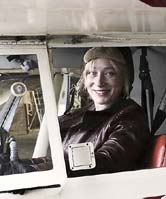Artist Simone Kærn discusses her inspiration for flying from Denmark to Afghanistan in a small 1961 Piper Colt airplane, and her experiences during the filming of “Flying Down to Kabul.”
WIDE ANGLE: Your flight to Afghanistan served two very significant purposes: one was to offer the opportunity of flying over Kabul to a young woman, and the other was an effort to make an artistic statement about flight and the idea of freedom. Did you ever differentiate between these two purposes?
Simone Kærn: No, I never differentiated between these two purposes of the project. Instead, I thought of them as being mutually exclusive concepts. They both intrinsically center around the idea of flight. When I read the Danish news article by Carsten Jensen about a young Afghan girl who sought to become a fighter pilot, I immediately identified with her. I knew that Farial was attracted to the same qualities of flight that initially caught my attention and provoked my passion for aviation.
In the film I attempted to describe that feeling of stimulation and freedom that comes from flying. This common ground with Farial was the impetus for my project. The pleasure Farial expressed when in the air over Kabul confirmed that she shared the same desire to experience the freedom of flight. Without this as a starting point, the artistic component of the project would have no basis.
WIDE ANGLE: In the film, most of the men you met at the airports appear to respond positively to your flight, especially those men who greet you in Afghanistan. What was your perspective on their attitude toward you? Were they actually as supportive as they appear to be in the film?
Simone Kærn: Well, it depended mostly on their curiosity about the topic of freedom and flight. You have to be willing to acknowledge the fact that there will be those people who accept the idea and those who reject it. There was an element of fear associated with the concept of freedom and flight for some we met along the way. On the other hand, there were others who saw us as a non-governmental project and recognized our goals.
Among people who viewed the project in this latter light, there were many who went to great lengths in order to assist us in any way possible. For example, at the first airfield in Afghanistan we met a young man who saw the project as a humanitarian effort, of sorts. During this period we were being asked to pay an exorbitant amount of money in landing fees, which we did not have. This young man helped explain the importance of our trip to the other men at the airfield, telling them that our flight represented much more than a typical client. It was an amazing experience to see that someone so far away could understand so plainly what our intentions were, and would make every attempt to help us. After negotiating with the men, he also contacted the next airfield in the flight path to Kabul on our behalf, compiled a navigation route that would best suit our plane’s capacity, and even checked the weather for our journey.
WIDE ANGLE: What was the most significant lesson you gained from this experience?
Simone Kærn: When situated in a familiar and comfortable environment, it is very easy to speculate on the danger of traveling to conflict areas, or even safe locations that are perceived as different from your own. It may be a natural reaction or one influenced by the surrounding societal norms. When you do make that extra effort to overcome those fears and step into another world with an open mind, often you find that the people are supportive. Furthermore, you realize that they share your same fears and misunderstandings about culture and experiences in other countries. This was a significant lesson of the trip for me. For instance, when we traveled to Greece, people who responded kindly to our efforts would warn us not to go to Turkey for one reason or another. We came to understand that these concerns were baseless through our interaction with people in Turkey, and soon they were warning us not to go to Iran based on similar logic from those in Greece. It became evident along the way that such ideas of fear are usually misconstrued notions about a country and its people due to a lack of exposure.
WIDE ANGLE: Besides your inability to fly over Bosnia and your very risky decision to illegally enter Afghanistan, what were some of the most difficult moments of the journey?
Simone Kærn: There are so many it is hard to recount them all. Generally, weather plays a large role in relation to the stress of flying in any country. This is especially true when flying in the Hindu Kush of Afghanistan. We were not entirely confident in the plane’s performance as we reached altitudes of 12,000 feet. If we were to run into a snowstorm in this area, there were not many options for landing. In the very unlikely event that we were able to land successfully in the case of an emergency, we would also have to face walking out of the largest mountain range in the world in a country plagued by landmines.
Another tense moment that was not touched upon in the film was our entry into Iran. Civil aviators are required to make contact with the air traffic controller previous to entering the airspace of Iran. If no contact is made prior to or upon arrival in Iranian airspace, they may very well identify your aircraft as a threat and attempt to shoot the plane down. We were not able to make this contact and were literally at the edge of our seats until we landed. I think it is important to mention that we would never want to give them the impression that these experiences are anything to brag about, or a cause for pity. No difficulty we encountered during our journey can be compared to what most Afghans have endured during decades of civil war. Furthermore, it probably takes more guts for Farial and her family to break Afghan cultural rules and exercise individuality and female independence than it takes for us to fly to Afghanistan.
“Rarely do you see a face, or a whole woman,” writes Carsten Jensen in “A Travel Letter: Behind the Veil in Kabul,” published in 2002 by the Danish newspaper DAGBLADET POLITIKEN. Jensen profiles Afghan women and men and discusses their experiences of life after the Taliban. The story of one young girl’s defiance and desire to become a fighter pilot caught the attention of artist Simone Kærn.


